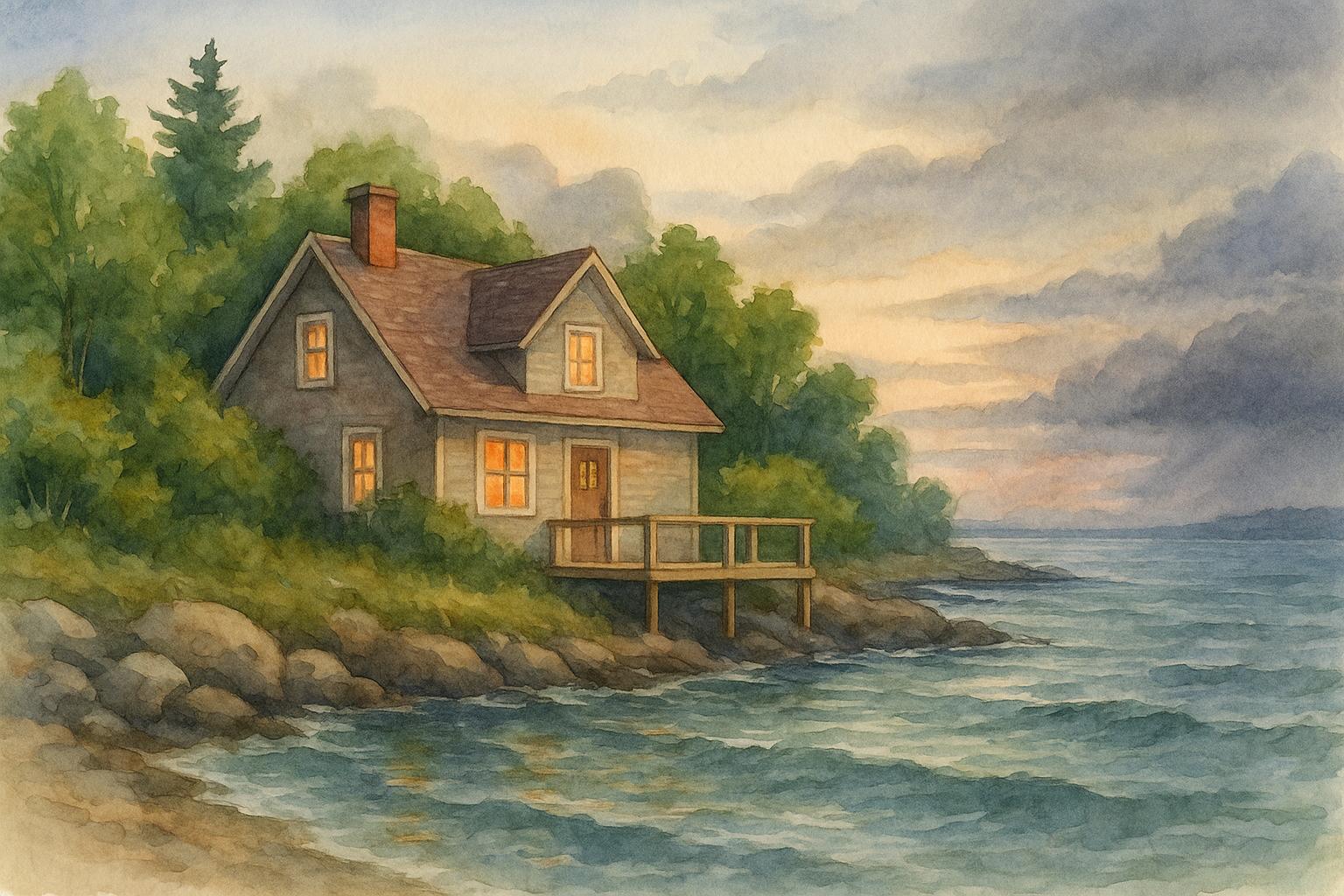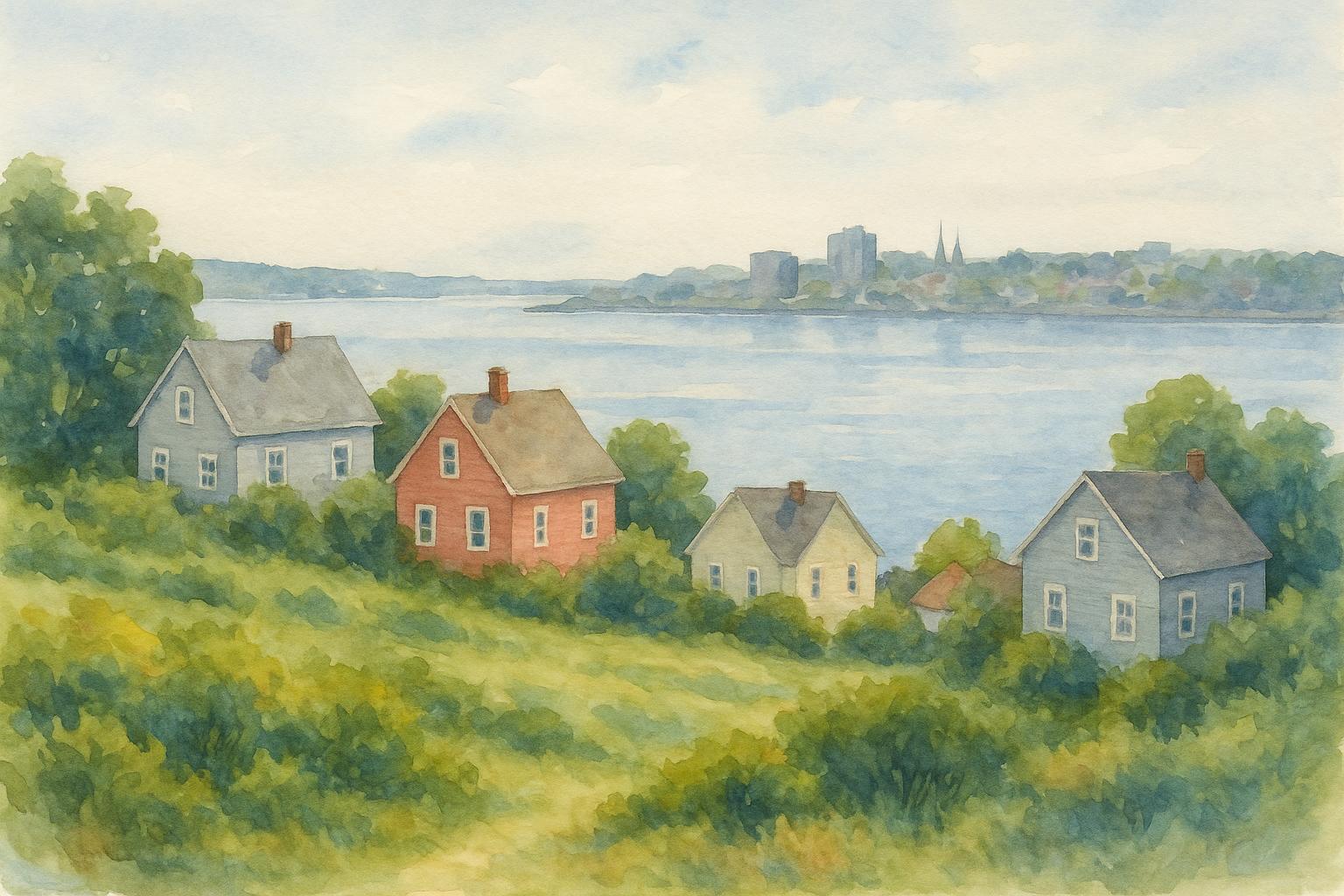Lunenburg’s heritage homes are architectural treasures, but they face modern safety challenges, especially for short-term rental owners. Balancing safety requirements with preserving historical features is key. Here’s how to make upgrades that respect both:
- Fire Safety: Install wireless smoke and carbon monoxide detectors, concealed sprinkler systems, and fire-retardant treatments for exposed wood. Ensure proper egress routes and fire stops in balloon-framed homes.
- Electrical Updates: Replace outdated wiring with safer options like cloth-covered Romex or surface-mounted conduit. Place outlets discreetly to avoid damaging original plaster and millwork.
- Structural Reinforcements: Address foundation issues, inspect for rot or damage in post-and-beam construction, and ensure chimneys are properly lined.
- Preservation of Key Features: Document original elements like wide-plank floors, hand-carved millwork, and window sashes. Work with contractors experienced in heritage properties to protect these details during upgrades.
For short-term rental compliance, meet local safety codes and consider expert management services like Casa Scotia to streamline inspections and certifications. These steps ensure safety while maintaining the charm that makes Lunenburg homes special.
Do Building Codes Apply To Older Homes? - CountyOffice.org
Assessing Safety Needs and Historic Features
When dealing with heritage homes, there’s a careful balancing act: preserving their timeless charm while ensuring they meet modern safety standards. Before diving into upgrades, it’s crucial to evaluate both the safety challenges and the unique historic elements that give the home its character. This process lays the groundwork for maintaining the home’s historic essence while addressing any safety concerns.
The assessment involves documenting original features and identifying safety gaps that could pose risks to guests or breach local regulations. By focusing on both areas, you can determine which safety upgrades are urgent and which historic details require the most protection during renovations.
Finding Key Historic Features to Keep
Start by documenting each room in detail. Look for both prominent and subtle historic elements. For example, original door hardware, such as rim locks and strap hinges, often reflects craftsmanship that’s impossible to replicate today. Similarly, window sashes with original glass panes often have slight imperfections that create the distinctive light patterns guests find so captivating.
Take note of architectural millwork, including crown mouldings, baseboards, and window casings. These features were often hand-carved by skilled local artisans. Even if layers of paint have dulled their beauty, careful restoration can reveal their intricate details.
Flooring is another area worth close attention. Wide-plank floors in Lunenburg homes, for instance, were typically made from old-growth timber, a material that’s no longer available. Look for other historical markers like mortise and tenon joinery in exposed beams, hand-forged nails, and original plaster walls reinforced with horsehair. These construction details are hallmarks of the home’s era and contribute significantly to its authenticity.
Document everything thoroughly with photographs and measurements. Create a basic floor plan that marks the location of each historic feature. This documentation will be invaluable when working with contractors, ensuring they understand the importance of preserving these elements.
Completing a Full Safety Inspection
Once you’ve catalogued the historic features, it’s time to assess modern safety risks. Inspections for heritage homes require professionals who are well-versed in both modern building codes and traditional construction methods. A standard home inspector might overlook critical issues or suggest fixes that could harm irreplaceable features.
Start with the electrical system, checking for outdated components like knob-and-tube or aluminum wiring. Ensure the number of outlets meets current rental codes. Structural assessments should focus on the foundation, load-bearing walls, and roof systems. Many Lunenburg homes have fieldstone foundations, which may have settled over time. Look for cracks, water damage, or crumbling mortar. In homes with post-and-beam construction, be on the lookout for signs of rot or insect damage, especially where wood meets stone or in poorly ventilated areas.
Fire safety is another critical concern for heritage homes. Balloon framing, common in older houses, creates vertical channels that can act like chimneys in the event of a fire. Inspect for fire stops between floors and ensure proper separation between living spaces and utility areas. Original chimneys might need relining, and egress routes from upper floors often require updates to meet current standards.
For these inspections, hire professionals with experience in heritage properties. Structural engineers familiar with traditional building techniques can spot issues that general contractors might miss. Likewise, electrical contractors experienced with older homes know how to install modern wiring without damaging plaster walls or exposing structural elements unnecessarily.
Based on the findings, create a prioritized list of safety concerns. Address life safety issues - like faulty wiring or blocked egress routes - immediately. Focus on upgrades that meet safety codes for short-term rentals without compromising the home’s historic character. Issues like foundation repairs, which may not be urgent, can often be scheduled around rental bookings.
This thorough assessment ensures that safety improvements protect both the well-being of guests and the historic charm that makes these homes so special.
Updating Electrical and Fire Safety Systems
Bringing safety systems up to current standards in a heritage home can feel like walking a tightrope. The goal is to ensure modern safety without losing the charm that makes these homes special. With careful planning and the right materials, you can achieve both. Here's how to modernize electrical and fire safety systems while preserving the historic character of your property.
Modern Electrical Updates That Respect History
When upgrading electrical systems, especially in heritage-rich areas like Lunenburg, it’s crucial to balance functionality with preserving original details. For example, while traditional knob-and-tube wiring might look nostalgic, it simply isn’t equipped to handle today’s electrical demands, especially in short-term rentals where guests expect modern conveniences.
One practical solution is using surface-mounted conduit, which can be painted to blend seamlessly with walls. This allows you to run new wiring without damaging original plaster or millwork. It’s a subtle approach that works particularly well in spaces like basements, utility rooms, or along baseboards.
For areas requiring concealed wiring, consider cloth-covered Romex. It provides the safety of modern wiring but mimics the appearance of period wiring, keeping the aesthetic intact.
Outlet placement is another key consideration. Instead of cutting into original plaster walls, install outlets in discreet spots like behind furniture or in corners. For larger rooms, floor outlets can be a clever solution, offering access to power without disrupting the visual flow of original millwork.
When it comes to upgrading electrical panels, location is everything. Modern panels are often larger than their historical counterparts, so choose spots like basements, utility closets, or even exterior locations to minimize their visual impact. Advance planning is key to ensuring these upgrades don’t interfere with the home’s layout or charm.
Finally, GFCI protection is a must in kitchens, bathrooms, and other wet areas, especially in rental properties. Rather than replacing period-appropriate outlets and switches, install GFCI breakers at the panel. This approach meets safety requirements while letting you keep hardware that matches the home’s era.
Improving Fire Safety While Keeping Character
Fire safety in heritage homes presents unique challenges. Original construction methods, like balloon framing, can actually increase fire risks by creating vertical pathways for flames to spread. Modern upgrades must address these risks without altering the home’s appearance.
Wireless smoke and carbon monoxide detectors are a great option, as they don’t require running new wiring through original walls or ceilings. Many wireless systems link detectors so that if one alarm sounds, all units are activated. Opt for low-profile designs that can be painted to match ceilings for a less obtrusive look.
In certain areas, heat detectors might be a better choice than smoke detectors. For instance, kitchens with wood-burning stoves or fireplaces often trigger false alarms with standard smoke detectors. Heat detectors respond to rapid temperature changes, reducing nuisance alarms while maintaining safety.
For homes with plaster construction, applying fire-retardant treatments to exposed wood in basements, attics, or utility areas can slow fire spread without changing the wood’s appearance. Focus on high-risk areas, like spaces around chimneys or near electrical equipment.
Adding a monitored fire alarm system provides an extra layer of protection, especially in rental properties. These systems contact emergency services automatically when triggered, which is invaluable when the property is unoccupied. Modern wireless systems can be installed without disrupting the home’s structure, and central monitoring panels can be placed in less visible areas.
Fire extinguishers are essential, but they don’t have to detract from the home’s aesthetic. Use concealed fire extinguisher cabinets built into existing millwork or place extinguishers in utility spaces where they’re accessible but not prominent.
Egress improvements can require creative solutions. For example, original staircases may be narrower than current codes allow, and upper-floor windows might not meet emergency exit standards. Enlarging window wells can improve basement egress, while escape ladders can provide a practical solution for upper floors when structural changes aren’t feasible.
In cases where additional measures are needed, consider installing sprinkler systems. Modern residential sprinklers use smaller pipes and heads than commercial systems, making them easier to integrate discreetly. Concealed sprinkler heads can be painted to match ceilings, and piping can often be routed through existing utility spaces.
Finally, fire doors may be required between certain areas, such as living spaces and utility rooms. Instead of opting for modern fire doors that clash with the home’s character, work with suppliers who specialize in fire-rated doors that match period styles and hardware. This way, you can maintain the home’s timeless appeal while ensuring it meets safety standards.
sbb-itb-b5e1074
Accessibility Updates
Preserving the historic charm of Lunenburg's heritage homes while making them accessible is no small task. However, with careful planning, accessibility features can be seamlessly integrated without compromising the character of these treasured properties.
Adding Accessibility Features
When adding ramps or elevators, it's essential to ensure they blend with the home's original architecture. For example, exterior ramps can be designed to complement the existing structure, using materials and styles that harmonize with the building's aesthetic. For multi-storey access, residential elevators are a practical solution. According to heritage accessibility guidelines:
"Conceal elevators: Integrate elevators behind custom millwork or wood panelling that complements the original design. Ensure the pit and shaft are constructed with materials compatible with the heritage aesthetic [1]."
Incorporating universal design principles ensures these spaces are welcoming and functional for a wide range of users, all while respecting the home's historical essence. Collaborating with local authorities is crucial to align updates with heritage bylaws and regulations. These thoughtful modifications not only enhance accessibility but also uphold safety and rental standards, ensuring the homes remain both liveable and compliant.
Meeting Regulations with Casa Scotia's Help

After implementing the necessary safety upgrades, the next step for heritage property owners is ensuring compliance with local regulations. In Lunenburg, short-term rentals in heritage properties must meet both stringent safety and preservation standards. Balancing these requirements can be tricky, especially for independent owners. That’s where expert support becomes invaluable.
Following Local Safety and Rental Rules
In Nova Scotia, short-term rental properties must adhere to updated safety regulations. Owners are often required to register their properties with the province and maintain valid safety certifications. For heritage properties, this means upgrading fire safety and electrical systems to meet the National Fire Code and Canadian Electrical Code - all while preserving the home’s historical features.
For instance, modern fire safety equipment like interconnected smoke detectors, carbon monoxide alarms, and fire extinguishers must be installed thoughtfully, ensuring they don’t detract from the property’s historic charm. Similarly, older electrical systems often need major updates to align with today’s safety standards. Regular inspections are key to staying compliant and addressing the unique challenges posed by heritage construction.
Accessibility improvements can also come into play. While full accessibility upgrades may not always be required for existing structures, any modifications should be carried out in a way that respects the home’s historical integrity, ensuring guest safety and comfort remain a priority.
How Casa Scotia Makes Heritage Property Management Easy
Casa Scotia specialises in managing heritage short-term rentals, helping property owners navigate the complex intersection of safety regulations and historic preservation. Their expertise ensures that Nova Scotia’s historic homes meet modern codes without losing their character.
Casa Scotia takes care of provincial registration and safety certifications, managing regular inspections and overseeing essential updates to fire safety and electrical systems. Their deep understanding of local regulations and heritage property requirements allows them to handle approval processes smoothly and efficiently.
To preserve the unique charm of heritage homes, Casa Scotia works with restoration experts who use materials and techniques that align with historical standards. This ensures that any repairs or upgrades maintain the original character of the property while meeting modern safety needs.
Beyond compliance, Casa Scotia develops customised safety protocols for guests. They provide detailed information about the property’s features and the locations of safety equipment, giving guests peace of mind while allowing them to appreciate the home’s historical significance.
For property owners, Casa Scotia offers a dedicated portal that provides updates on compliance and maintenance. Monthly reports detail safety inspections and repair activities, keeping owners informed without requiring hands-on involvement. With both year-round and peak-season management plans, Casa Scotia allows heritage property owners to choose the level of service that suits their needs best.
Conclusion: Finding the Right Balance
Upgrading heritage homes in Lunenburg requires careful attention to preserving their historic charm while meeting modern safety standards.
Take stock of the features that define your home's unique character - like original hardwood flooring, intricate millwork, or heritage windows. Then, explore ways to safeguard these elements during essential upgrades, such as modernizing electrical systems, installing fire detection tools, or reinforcing structural integrity.
Working with skilled professionals can make all the difference. Their expertise ensures that your upgrades are not only safe but also respectful of your home's historical significance, creating solutions tailored to your property’s needs.
For those managing short-term rentals, Casa Scotia offers a seamless way to stay on top of local regulations. Their services include real-time updates and detailed monthly reports, helping you maintain compliance while providing guests with modern comforts.
Heritage homes in Lunenburg are more than just buildings - they’re a glimpse into Nova Scotia’s rich history. By combining thoughtful safety upgrades with expert management, these homes can continue to share their stories for generations to come.
FAQs
How can I upgrade my heritage home in Lunenburg to meet safety standards while preserving its historical charm?
To renovate your heritage home in Lunenburg while keeping its historical character intact, you'll need to follow a clear process that aligns with local heritage regulations. The first step is to submit a written request to the Planner, detailing the changes you want to make. The Planner will then assess whether your proposed updates fall under substantial or non-substantial changes as outlined in Policy 027.
For changes deemed substantial, your request will go through a review by the Heritage Advisory Committee and may also require approval from the Municipal Council. This thorough review process ensures that upgrades - like updating electrical systems or installing fire safety features - preserve the architectural integrity and historical essence of your home. It’s always a good idea to work with professionals who specialize in heritage properties to ensure safety improvements blend seamlessly with the home's original design.
What are some discreet ways to upgrade electrical and fire safety systems in heritage homes without compromising their historic charm?
Upgrading the electrical and fire safety systems in heritage homes requires a careful approach to protect their historic charm. Key updates often include replacing old wiring, adding ground fault circuit interrupters (GFCIs) and arc-fault circuit interrupters (AFCIs), and modernizing the electrical panel. These upgrades are essential for ensuring safety while aligning with today's standards.
To preserve the home's original aesthetic, new wiring can be discreetly routed through existing walls, basements, or attics, keeping visible changes to a minimum. For an even more cohesive appearance, choose outlet covers and fixtures that suit the home's period style. In some cases, surface-mounted wiring with decorative modern conduits can enhance functionality while blending beautifully with the vintage design.
How does Casa Scotia help heritage homeowners in the Lunenburg area meet safety standards while preserving their home's historic charm?
Casa Scotia specializes in guiding heritage property owners in the Lunenburg area through the complexities of local safety regulations, all while preserving the historic charm of their homes. Their approach focuses on practical solutions for updating critical features like electrical systems, fire safety measures, and structural reinforcements. The goal? To meet safety requirements without sacrificing the architectural beauty and historical value of these cherished properties.
Whether you're a homeowner or manage a short-term rental, Casa Scotia highlights the importance of using tools, materials, and techniques that harmonize with the original design. This thoughtful balance helps you retain your property's unique character while ensuring it stays safe and fully compliant with local standards.
Related Blog Posts
- Halifax, Dartmouth, Bedford and Sackville: Where STRs Are Allowed and What Permits You Need
- Lunenburg and Surrounding Communities: Compliance, Heritage Considerations and Guest Demand
- Windsor and Hantsport: Converting a Second Home to an STR the Right Way
- Converting a Basement Suite to a Compliant STR: Egress, Fire and Insurance



